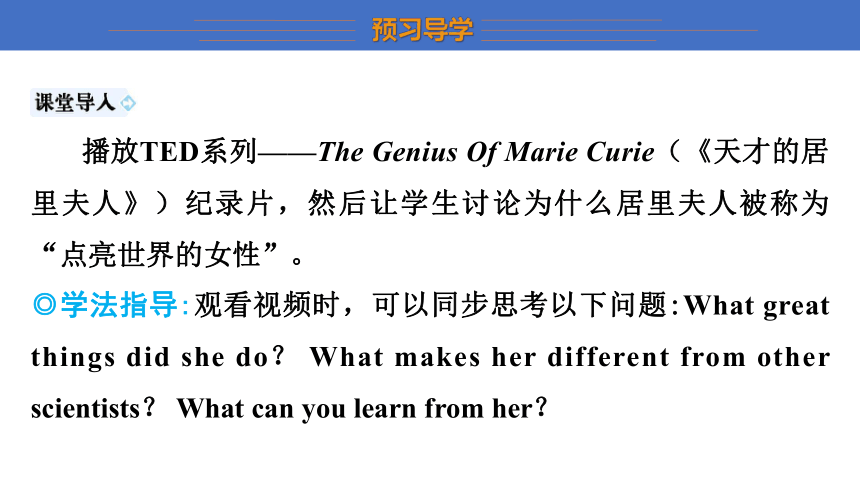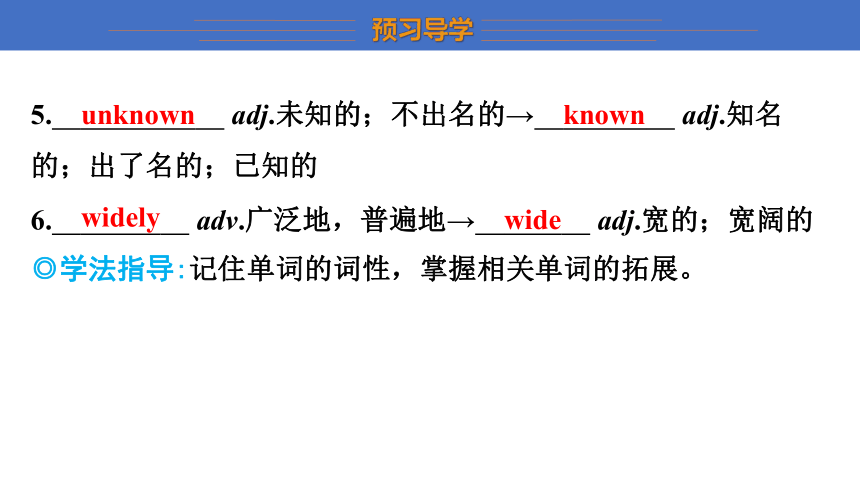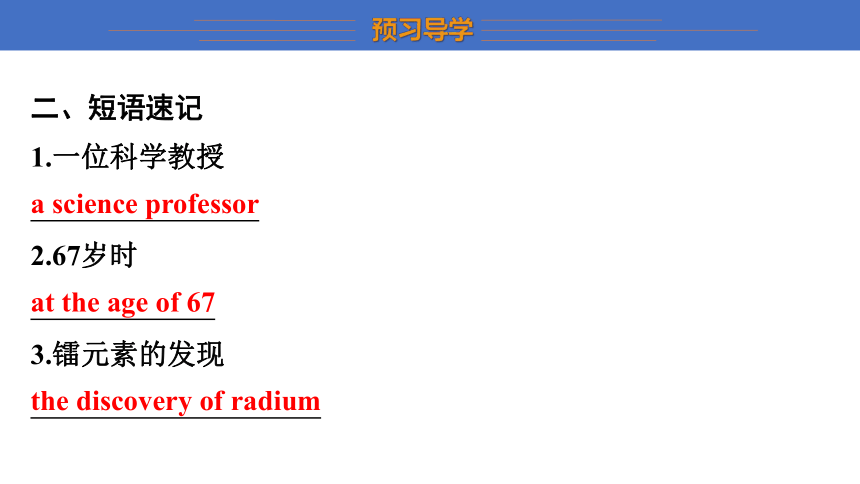Unit 2 Great people Integrated skills & Study skills课件(共23张PPT) 牛津译林版九年级英语下册
文档属性
| 名称 | Unit 2 Great people Integrated skills & Study skills课件(共23张PPT) 牛津译林版九年级英语下册 |  | |
| 格式 | pptx | ||
| 文件大小 | 691.0KB | ||
| 资源类型 | 教案 | ||
| 版本资源 | 牛津译林版 | ||
| 科目 | 英语 | ||
| 更新时间 | 2024-01-12 20:13:04 | ||
图片预览









文档简介
(共23张PPT)
九年级·英语·译林版·全一册
Unit 2 Great people
Integrated skills & Study skills
1.能背诵本课时的重点单词及短语。
2.能利用听力微技能获取居里夫人的生平与伟大成就。
3.能通过对话谈论自己最钦佩的人。
1.完成预习导学,达成学习目标1。
2.完成任务驱动一、二,达成学习目标2。
3.完成任务驱动三,达成学习目标3。
播放TED系列——The Genius Of Marie Curie(《天才的居里夫人》)纪录片,然后让学生讨论为什么居里夫人被称为“点亮世界的女性”。
◎学法指导:观看视频时,可以同步思考以下问题:What great things did she do? What makes her different from other scientists? What can you learn from her?
一、词汇记忆
根据中文写出英语单词
1. mathematics n.数学
2. scientist n.科学家→ science n.科学
3. laboratory (=lab) n.实验室
4. discovery n.发现;发现物→ discover vt.发现
mathematics
scientist
science
laboratory (=lab)
discovery
discover
5. unknown adj.未知的;不出名的→ known adj.知名的;出了名的;已知的
unknown
known
6. widely adv.广泛地,普遍地→ wide adj.宽的;宽阔的
◎学法指导:记住单词的词性,掌握相关单词的拓展。
widely
wide
二、短语速记
1.一位科学教授
a science professor
2.67岁时
at the age of 67
3.镭元素的发现
the discovery of radium
a science professor
at the age of 67
the discovery of radium
4.在一场交通事故中
in a traffic accident
5.故事的结局
the end of the story
6.不为人类所知
be unknown to humans
7.推动……的使用
push for the use of...
in a traffic accident
the end of the story
be unknown to humans
push for the use of...
8.被广泛使用
be widely used
◎学法指导:注重理解、积累并运用短语。
be widely used
伟人事迹
·导学建议·
两人一组进行合作,一问一答,初步了解居里夫人的生平,降低接下来的听力难度,提升学生信心。
参考课本P29 Part A1上端内容,补全对话,词数不限。
A:Where was Marie Curie born?
B:1.She was born in the city of Warsaw, Poland.
A:Where did she move when she was 24?
She was born in the city of Warsaw, Poland.
B:2.She moved to Paris, France when she was 24.
A:What did she discover in 1898?
B:3.She discovered radium in their laboratory in 1898.
A:How many times did she win the Nobel Prize?
B:4.She won the Nobel Prize twice during her lifetime.
A:When did she die?
B:5.She died at the age of 67./In 1934
She moved to Paris, France when she was 24.
She discovered radium in their laboratory in 1898.
She won the Nobel Prize twice during her lifetime.
She died at the age of 67./In 1934
◎学法指导:先完成补全对话,再与同伴进行对话操练,然后完成Part A1部分下端可以填写的内容,最后可以小组内共同讨论剩余空格的答案,进行一定的猜测。
听力训练
·导学建议·
先要求学生分析表格,然后进行猜测,最后做听力并验证。
听课文P30 Part B部分 录音,完成下列表格,词数不限。
Who Why
Simon Neil Armstrong Because it was 1. brave of him to go to a place that 2. was unknown to humans at that time.
Millie Marie Curie Because she 3. won the Nobel Prize twice and pushed for the use of 4. X-ray machines , which are now widely used in hospitals.
brave
was unknown to
won the Nobel Prize
X-ray machines
twice
◎学法指导:独立完成上面的练习,利用句子的内在逻辑进行一定的猜测。
对话模仿
·导学建议·
让学生从下面四位名人中选取一位,根据对话模板进行对话模仿,鼓励学生自由创作,不必拘泥于模板。
A:Who do you admire the most?
B:...
A:Why do you admire him/her?
B:Because...
A:What do you want to be in the future?
B:I want to be a... like...
◎学法指导:可以借助书本中关于四位名人的信息准备对话,也可以改编对话的模式,增加对话轮次。
It was brave of him to go to a place that was unknown to humans at that time.他很勇敢到一个当时人类未知的地方去。
◎观察思考:
A young unknown person played the leading role.演主角的是一个名不见经传的年轻人。
The side effects that the medicine has are unknown to us.我们不知道这种药物的副作用。
◎用法总结:
unknown作形容词,意为“未知的;不出名的”,反义词为known,意为“出名的”。常见短语为be unknown to...,意为“对……是未知的”。
根据句意及括号内的单词提示填空。
1.He was trying to count the stars for some unknown (know) reasons.
2.Zhong Nanshan is known (know) as a great doctor.
unknown
known
She also pushed for the use of X-ray machines, which are now widely used in hospitals.她还推动了X光设备的使用,这种设备现已在医院被广泛使用。
◎观察思考:
The idea is now widely accepted. 这个思想现在已被普遍接受。
Our classroom is 10 metres long and 8 metres wide. 我们的教室长10米,宽8米。
The door was wide open. 这扇门四敞大开。
◎用法总结:
widely 表示抽象意义上的“宽”,意为“广泛地,普遍地”;wide作形容词,意为“宽广的,宽阔的;……宽的”。
翻译句子。
1.这条河有10米宽。
The river is 10 meters wide.
2.英语在世界范围内被广泛使用。
English is widely used in the world.
The river is 10 meters wide.
English is widely used in the world.
九年级·英语·译林版·全一册
Unit 2 Great people
Integrated skills & Study skills
1.能背诵本课时的重点单词及短语。
2.能利用听力微技能获取居里夫人的生平与伟大成就。
3.能通过对话谈论自己最钦佩的人。
1.完成预习导学,达成学习目标1。
2.完成任务驱动一、二,达成学习目标2。
3.完成任务驱动三,达成学习目标3。
播放TED系列——The Genius Of Marie Curie(《天才的居里夫人》)纪录片,然后让学生讨论为什么居里夫人被称为“点亮世界的女性”。
◎学法指导:观看视频时,可以同步思考以下问题:What great things did she do? What makes her different from other scientists? What can you learn from her?
一、词汇记忆
根据中文写出英语单词
1. mathematics n.数学
2. scientist n.科学家→ science n.科学
3. laboratory (=lab) n.实验室
4. discovery n.发现;发现物→ discover vt.发现
mathematics
scientist
science
laboratory (=lab)
discovery
discover
5. unknown adj.未知的;不出名的→ known adj.知名的;出了名的;已知的
unknown
known
6. widely adv.广泛地,普遍地→ wide adj.宽的;宽阔的
◎学法指导:记住单词的词性,掌握相关单词的拓展。
widely
wide
二、短语速记
1.一位科学教授
a science professor
2.67岁时
at the age of 67
3.镭元素的发现
the discovery of radium
a science professor
at the age of 67
the discovery of radium
4.在一场交通事故中
in a traffic accident
5.故事的结局
the end of the story
6.不为人类所知
be unknown to humans
7.推动……的使用
push for the use of...
in a traffic accident
the end of the story
be unknown to humans
push for the use of...
8.被广泛使用
be widely used
◎学法指导:注重理解、积累并运用短语。
be widely used
伟人事迹
·导学建议·
两人一组进行合作,一问一答,初步了解居里夫人的生平,降低接下来的听力难度,提升学生信心。
参考课本P29 Part A1上端内容,补全对话,词数不限。
A:Where was Marie Curie born?
B:1.She was born in the city of Warsaw, Poland.
A:Where did she move when she was 24?
She was born in the city of Warsaw, Poland.
B:2.She moved to Paris, France when she was 24.
A:What did she discover in 1898?
B:3.She discovered radium in their laboratory in 1898.
A:How many times did she win the Nobel Prize?
B:4.She won the Nobel Prize twice during her lifetime.
A:When did she die?
B:5.She died at the age of 67./In 1934
She moved to Paris, France when she was 24.
She discovered radium in their laboratory in 1898.
She won the Nobel Prize twice during her lifetime.
She died at the age of 67./In 1934
◎学法指导:先完成补全对话,再与同伴进行对话操练,然后完成Part A1部分下端可以填写的内容,最后可以小组内共同讨论剩余空格的答案,进行一定的猜测。
听力训练
·导学建议·
先要求学生分析表格,然后进行猜测,最后做听力并验证。
听课文P30 Part B部分 录音,完成下列表格,词数不限。
Who Why
Simon Neil Armstrong Because it was 1. brave of him to go to a place that 2. was unknown to humans at that time.
Millie Marie Curie Because she 3. won the Nobel Prize twice and pushed for the use of 4. X-ray machines , which are now widely used in hospitals.
brave
was unknown to
won the Nobel Prize
X-ray machines
twice
◎学法指导:独立完成上面的练习,利用句子的内在逻辑进行一定的猜测。
对话模仿
·导学建议·
让学生从下面四位名人中选取一位,根据对话模板进行对话模仿,鼓励学生自由创作,不必拘泥于模板。
A:Who do you admire the most?
B:...
A:Why do you admire him/her?
B:Because...
A:What do you want to be in the future?
B:I want to be a... like...
◎学法指导:可以借助书本中关于四位名人的信息准备对话,也可以改编对话的模式,增加对话轮次。
It was brave of him to go to a place that was unknown to humans at that time.他很勇敢到一个当时人类未知的地方去。
◎观察思考:
A young unknown person played the leading role.演主角的是一个名不见经传的年轻人。
The side effects that the medicine has are unknown to us.我们不知道这种药物的副作用。
◎用法总结:
unknown作形容词,意为“未知的;不出名的”,反义词为known,意为“出名的”。常见短语为be unknown to...,意为“对……是未知的”。
根据句意及括号内的单词提示填空。
1.He was trying to count the stars for some unknown (know) reasons.
2.Zhong Nanshan is known (know) as a great doctor.
unknown
known
She also pushed for the use of X-ray machines, which are now widely used in hospitals.她还推动了X光设备的使用,这种设备现已在医院被广泛使用。
◎观察思考:
The idea is now widely accepted. 这个思想现在已被普遍接受。
Our classroom is 10 metres long and 8 metres wide. 我们的教室长10米,宽8米。
The door was wide open. 这扇门四敞大开。
◎用法总结:
widely 表示抽象意义上的“宽”,意为“广泛地,普遍地”;wide作形容词,意为“宽广的,宽阔的;……宽的”。
翻译句子。
1.这条河有10米宽。
The river is 10 meters wide.
2.英语在世界范围内被广泛使用。
English is widely used in the world.
The river is 10 meters wide.
English is widely used in the world.
